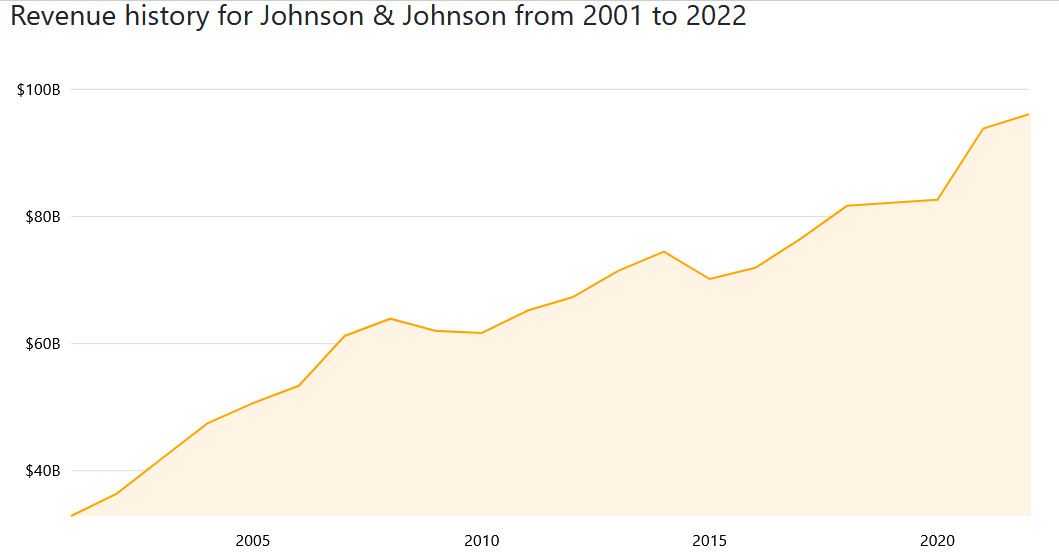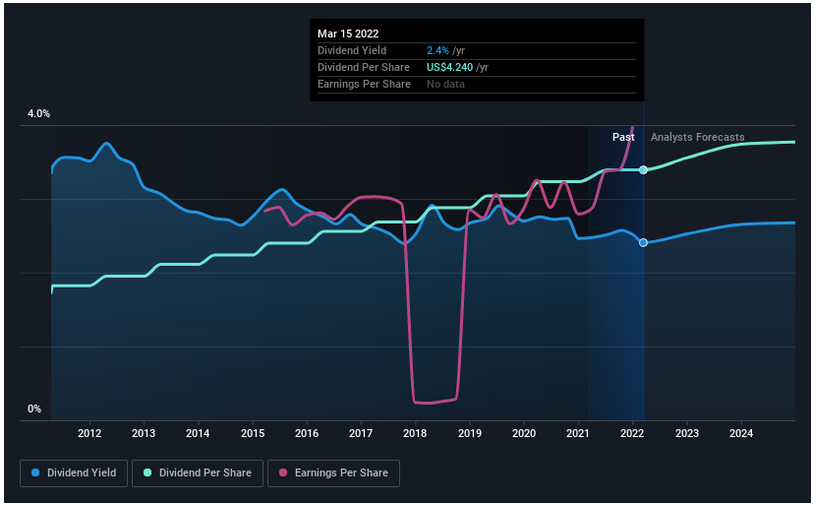Introduction
Johnson and Johnson (JNJ) are one of the largest healthcare firms worldwide that operate in three business segments. Segments include pharmaceutical, medical devices and diagnostics, and consumer products. Drugs for mental illness, cardiovascular diseases, family planning, allergies, pain management, and immunotherapy belongs to the pharmaceutical segment. The medical devices and diagnostics segment include joint replacement, surgical and patient care equipment and devices, contact lenses, diagnostic products, and coronary stents. Its consumer product line consists of Neutrogena skin and care, Johnson’s baby care, Stayfree feminine hygiene products, and many more. JNJ has a network of over 200 companies operating in 57 countries. Throughout its operations, the company strives to improve access and affordability of healthcare products and create a healthier community and environment for everyone. In addition, the company embodies a commitment to generating revenue through transparency and accountability while promoting ideal organizational culture, ethics, and value for humanity.
The Company History
Johnson and Johnson (JNJ) began as a small company that created surgical dressings in 1886. Joseph Lister’s discovery that germs were a source of infection in operation rooms inspired Robert Wood Johnson and his brothers to believe they could provide a viable solution (Reed, 2020). Therefore, Robert Wood Johnson and his two brothers, Edward Mead Johnson and James Wood Johnson, began producing dressings in 1886. The company found a ready market for its dressing products because Lister’s solution of spraying the operation room was impractical. The first product by JNJ was an improved medicinal plaster, which used medical compounds mixed in the adhesive (Reference for Business, 2019). Soon after, the company launched a series of surgical products and increased its reputation for creating improved versions of regular health care and sanitization products.
Among other achievements, JNJ produced the first cheap and commonly available sanitary pads, dental floss, oil, powder, and shampoos for infants and babies. Furthermore, it developed antiseptic, low-cost surgical sutures, and sterilized plaster for closing post-treatment wounds, including mass-market first-aid kits and manuals (Reed, 2020). These advancements solidified the business’s reputation as a producer of hospital-grade medical supplies and consumer-level healthcare products. Between 1930 and 1950, JNJ developed its corporate structure, turning into a decentralized family of companies operating under Johnson and Johnson.
Johnson and Johnson concentrated on expanding its pharmaceuticals business in the 1960s and 1970s. The company continued to market its medical equipment products, ranging from surgical tools to at-home bandages, while simultaneously developing therapies for various ailments, including pain reduction, mental problems, and vision care (Reed, 2020). Johnson & Johnson has expanded in most medical research and development fields since the 1980s. The first disposable contact lens, commonly prescribed medications for treating depression and schizophrenia, HIV/AIDS medications, and the first coronary stent are just a few of the company’s innovations (Reed, 2020). Significant developments also happened in 2006 when JNJ acquired other brands, such as Pfizer Consumer Healthcare and the Listerine product line belonging to Joseph Lister.
Since 2006, the company has experienced enormous growth, and today it has more than 250 distinct subsidiary companies operating in almost every area of medicine, with annual sales of more than $70 billion. Despite the success, the company has encountered several problems during its growth. For instance, JNJ was forced to withdraw from the prescription heartburn medication in 2000 after the drug was linked to deaths and cases of cardiac irregularities (Reference for Business, 2019). However, overall, the company has made significant progress since 1886, beating all the odds to become one of the best pharmaceutical companies.
Organization Ethics and Current Events
Johnson and Johnson’s compliance structure comprises experienced and qualified professionals functionally independent from commercial interests. These professionals ensure compliance with applicable laws and regulations, including healthcare compliance and anti-corruption. Employees must complete the Code of Business Conduct (CBC) training every two years (Johnson & Johnson, 2022). Johnson and Johnson consider the supply chain as an extension of the business and expect all suppliers to uphold the same level of integrity and compliance as the company. Therefore, JNJ provides a channel for all employees, customers, third-party agencies, and other partners to report potential violations of the CBC or other company policies (Johnson & Johnson, 2022). In addition, JNJ has a clear, thorough, and robust direction of ethical behaviors across its branches to provide a coordinated and uniform for employees and contingent workers.
Despite the commitment to promoting ethical business operations and transparency, JNJ has been in the spotlight for violations of the law and environmental conservation measures. For instance, JNJ was fined more than $2.2 billion to resolve criminal and civil liability related to Risperdal, Invega, and Natrecor (Ethical, 2022). In the lawsuit, the company was found guilty of promoting uses of drugs found unsafe and infective by the FDA, including paying kickbacks to physicians and a U.S. long-term care pharmacy provider. In addition, the company has been punished for price-fixing in the supermarket by a French competitive watchdog, among other violations. Despite the negative reputation, the company has done well in promoting climate change initiatives, removing toxic chemicals from its products, and recycling efforts. For example, the company Bronze Member of the Sustainable Companies Network, the premier peer-to-peer, learning, and networking organization, was created to support brands in achieving their sustainability goals and ultimately becoming the leaders of the next sustainable economy (Ethical, 2022). With its life-saving medications, products, and equipment, the firm seeks to improve the health of its workers, our communities, the environment, patients, consumers, and everyone else it serves.
Current Events at Johnson and Johnson Company
The company has made rapid progress toward creating a cleaner and safe environment worldwide. For instance, JNJ has committed considerably to transitioning to renewable electricity in its facilities across various countries. The energy sources will come from a new solar field in the United States, with 55 megawatts of renewable energy annually (Goad, 2021). It shows the company’s long-term dedication to improving our planet’s health. The company has also leveraged its core business strategies to drive positive social impact.
Johnson and Johnson helped expand access to COVID-19 vaccines worldwide by making its Janssen COVID-19 vaccine available. In addition, it demonstrated its corporate social responsibility by harnessing its capabilities, scientific expertise, and experience to respond to the coronavirus pandemic. Besides positive social impact, JNJ has continued its determination to expand and diversify. For example, JNJ will spend $16.6 billion to acquire Abiomed, a cardiovascular technology business, to bolster its medical device segment (Business Standard, 2022). With over 144,000 employees worldwide since its founding in 1886, the corporation has developed into one of the world’s most extensive and diverse healthcare organizations. The company continues to work consistently towards changing the trajectory of health for humanity.
Johnson and Johnson Marketing Strategies, Finances, and Accounts
Johnson and Johnson has categorized its products into three segments: consumer products, pharmaceuticals, and equipment. The product ranges from baby, skin, oral, wound, women’s health care, contraceptives, and medical equipment. The corporation adheres to a well-planned pricing policy, which comprises keeping prices within the range of the consumer price index. It uses the same index in the U.S. across its subsidiary branches that consider affordable pricing for consumers. Besides, the company has worked closely with the government to keep prices of medical items reasonable as part of its responsibility to society. Mainly. The pricing of JNJ products depends on various factors like target segment, demand and supply, production cost, and customer purchase capacity. Because consumers are willing to pay more for high-quality goods and their family’s health, prices have been kept higher for various products, such as baby care and consumer goods.
The company’s market placement strategy includes a vast distribution network, making its products widely available. For instance, its products are easily accessible at retail stores and modern markets. Besides its presence in several countries, JNJ has exploited the various online shopping portals and sites to increase sales. In addition, Johnson and Johnson has invested significantly in R&D and advertising as its promotion strategy. Its commercials are sent worldwide via various media, including magazines, billboards, newspapers, etc. Overall, the company has mainly focused on building long-term assets for its brand, long-term management, sustainable customer loyalty, and creating value for shareholders over time.
Equity, Revenue, and Financial Position of Johnson and Johnson
Johnson and Johnson produced a solid financial performance in 2021 while also keeping up its investment in long-term growth acceleration. For example, the company sales revenue increased significantly from 2019 to 2020 and from 2020 to 2021 (see figure 3). The company has existed for a long time and has a recognized brand and strong product portfolio. Besides, it has offered investors cash and equity returns for extended periods. A review of the equity returns reveals that the business is flourishing and has given back about 9% to shareholders in the previous 12 months (Damchevski, 2022).
Additionally, investors can get a stock return of up to 12% when considering dividends. JNJ has about a 2.4% dividend yield per year, closer to the industry standard of 2.5% (see figure 2). Furthermore, a financial analysis of the company’s statements reveals that above 50% of the profits were shared as dividends in the last 12 months. The payout of above 50% indicates the business is mature and has a limited aspiration to take on many growth projects. Therefore, it benefits shareholders since they are left with reliable cash returns.
The Culture, People, and Diversity at Johnson and Johnson
Johnson and Johnson emphasize key aspects like agility, collaboration, customer, and diversity to achieve its corporate goals. Agility entails quick and effective responses to changes in the marketplace and seizing new opportunities. The company strives to rapidly iterate between making sense of the market and executing marketing decisions to adapt to the current market. Alongside working together within teams and the business, employees are required to put the needs of the consumers first. It includes listening to customer needs and prioritizing them to improve customer satisfaction and the company’s corporate image. Besides promoting a diverse and inclusive workplace, JNJ requires employees to demonstrate courtesy and treat each other with dignity.
The company recognizes that innovation thrives when diverse perspectives come together and people feel comfortable being themselves. The company has made a significant effort to recruit from various groups, including gender balance, the LGBTQ community, and generation Z, to promote inclusivity and cohesion in the workplace. Other efforts made by the company to make the workplace a better place include offering family benefits, health insurance coverage, and general wellness of employees. For example, JNJ was named in the top 10 of Seramount’s 100 Best Companies 2022 for being a mum-friendly employer (Ethical, 2022). It offers comprehensive benefits to families, including paid parental leaves that are gender-neutral, phase-back initiatives, leave for grieving following miscarriages, reimbursement for reproductive costs, and expanded mental health benefits for workers (Ethical, 2022).
Johnson and Johnson company policies guide employees transitioning to physical spaces and everything in between. For instance, the company is keen to address everything in its facilities, including bathrooms, in new designs to shape thinking for the future. Overall, JNJ collaborates in teams and continuously shares and refines critical skills and methods to improve its working environment for all employees. The company also values each person’s unique perspective and approach to fostering an environment that embraces diversity.
Organizational Goals of Johnson and Johnson
Johnson and Johnson believe good health is the foundation for good lives, thriving communities, and forward progress. Therefore, it strives to improve access to quality and affordable healthcare products, create healthier communities, and support environmental preservation. In its over 100 years of operation, the company has committed to setting a clear example of transparency and accountability. Today, the company continues to live its values by changing the trajectory of health through diversity, sustainability, and practicing corporate social responsibility to various communities. For example, the organization has been at the forefront of promoting forest conservation, removal of toxic from its products, green energy use, and other environmental conservation initiatives. The organization also has a longstanding commitment to tackling health challenges facing the underserved population in the U.S. and other countries worldwide.
The continued improvement and success of the company are attributed to its core values in the responsibility standards for suppliers. Standards for suppliers reflect in the company’s internal values and expectations, built on business relationships directed by trust, mutual respect, and transparency. Besides trust, mutual respect, and openness, JNJ seeks relationships with suppliers who share its vision, ensuring both the business and communities realize economic, social, and environmental benefits. Johnson and Johnson also believe consumers deserve consistent, reliable, high-quality products and services. Focusing on quality and compliance throughout the product life circle has ensured that the company continues to supply top-quality products that help customers achieve or maintain good health and well-being. In addition to quality, JNJ emphasizes creating cost and resource efficiency, which help the company become more sustainable over the long term.
Suitability for Investor SWOT Analysis
The healthcare giant has been a stable investment in the past five years. Financial statement values in this context have been rounded off to the next value for generalization purposes. Johnson and Johnson’s good economic performance is a significant factor in why it has been a wise investment. The business generated a net profit of over $17 billion in the previous 12 months on sales of above $90 billion, for a profit margin of close to 18% (see figure 1) (Johnson & Johnson, 2022, p. 42). Additionally, it produced a free cash flow of just under $20 billion throughout that time. As Johnson & Johnson spins off its consumer-health section, a slowly expanding business area, performance should continue to improve.
The main reason to buy shares at JNJ stock is its stability and dividend, which currently yields over 2.5%. Having raised its payout for the last 60 years, long-term investors can expect to earn more rewards in the years to come if the company remains profitable. However, growth investors may consider alternatives to JNJ as the company has been underperforming in the past five years. Relief may, however, come from the company’s decision to move away from consumer health and focus on better-performing segments. For instance, focusing on a better-performing segment could increase its growth prospect, but the transition’s success would start yielding benefits for investors in the next year.
The company’s current assets have increased since 2010, and so for current liabilities (see figure 3). As of December 31, 2021, the current ratio for JNJ was close to 1.3. The ratio indicates that JNJ is better placed to maximize the existing assets on its balance sheet to satisfy its current debt and other payables. Financial leverage also allows companies to use the additional capital for business operations, allowing equity owners to retain excess profit generated by the debt capital. Therefore, management may use its assets efficiently, which is ideal for investors. The company dividends also seem affordable and reliable and provide a 2.4% yearly cash return. Johnson and Johnson is a company that investors must keep watching for potential opportunities as they move from speculative to reliable stocks.
Recommendations and Conclusion
The company’s ability to immediately use its partnerships and scientific knowledge to develop COVID-19 vaccines was commendable. Nevertheless, JNJ needs to keep working on its Janssen COVID-19 Vaccine to prepare for impending pandemics because the threat of epidemics is still genuine. For instance, the company should strive to improve its ability to respond to health and security threats within 12 or fewer months, drawing lessons from the coronavirus pandemic. It includes developing key partners with other international stakeholders and strengthening existing ones to create next-generation solutions for preventing and fighting pandemics.
As part of JNJ’s social corporate responsibility, the company should help strengthen health systems, given its presence and influence in many countries. Johnson and Johnson should commit to filling the gap by investing in recruiting, training, retaining, and mobilizing frontline health workers. Its effort to promote human and environmental health through sustainable energy is commendable. Therefore, the company should strive to achieve carbon neutrality by using 100% renewable energy, as highlighted in its vision.
In summary, JNJ is a profitable company that has remained stable for over 60 years. Its continued growth and success since 1886 are attributed to its quality and efficient pharmaceutical product, diversity in its workforce, and commitment to sustainable production. The company has also fulfilled its cooperate social responsibility by promoting environmental conservation, producing healthy products, and developing solutions to fight pandemics like the coronavirus. Overall, the company offers potential opportunities for investors as they move from speculative to reliable stocks.
References
Business Standard. (2022). J&J to buy cardiovascular technology Abiomed in $16.6 billion deal. Business Standard. Web.
Damchevski, G. (2022). Stability and pricing power – Why Johnson & Johnson’s (NYSE:JNJ) 2.4% dividend is worth your time. Simple Wall. Web.
Ethical. (2022). Johnson & Johnson: Company assessment. Ethical Guide. Web.
Goad, K. (2021). How Johnson & Johnson is working to create a healthier planet. Jonhson and Johnson. Web.
Johnson & Johnson. (2022). Johnson & Johnson 2021 annual report. Johnson & Johnson. Web.
Reed, E. (2020). History of Johnson & Johnson: Timeline and facts. The Street. Web.
Reference for Business. (2019). Johnson & Johnson – Company profile, information, business description, history, background information on Johnson & Johnson. Reference for Business. Web.
Appendix



